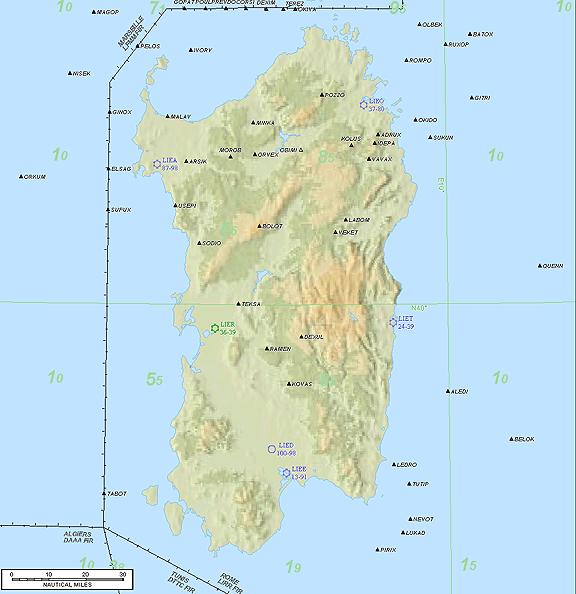
Trip to Sardinia - June 2010
This article describes an IFR (airways) trip from Shoreham (EGKA) to Cagliari (LIEE) in Sardinia, Italy.

Procedurally, the flight was very similar to other airways flights I have done which can be found here.
Here is a glossary for non-aviation readers.
Aircraft
The aircraft is a 2002 Socata TB20GT which has a zero-fuel "book" range of approximately 1100nm and an economical cruise speed of 155kt TAS at 10,000ft. Extra economical cruise power settings can extend the zero-fuel range to 1300nm which, according to FAA rules, translates to approximately 1100nm with IFR reserves. In practice, the range is determined by the choice of alternate airports. It has a ceiling of about 20,000ft and is equipped with oxygen. It is not certified for flight into icing conditions but has a TKS de-iced propeller. This is the actual aircraft
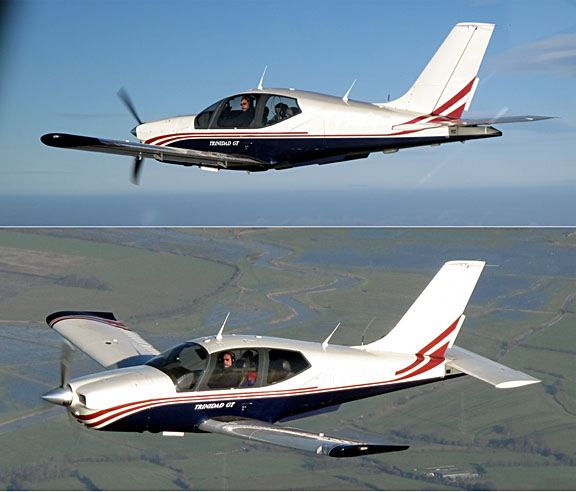
Navigation equipment includes a KLN94 IFR/BRNAV GPS and a KMD550 MFD and these are used for primary navigation.
The aircraft has a KFC225 autopilot which can track VOR/GPS/LOC/ILS and fly a preset altitude or a preset VS. There is an additional battery powered Garmin 496 GPS which also provides an audio terrain warning (TAWS) function with a European terrain and obstacle database. The TAWS function projects the current trajectory for 2 minutes and if there is a terrain conflict, one gets a "pull up" type audio warning whose tone gradually becomes more urgent. A WX500 stormscope is also installed, which displays on the MFD
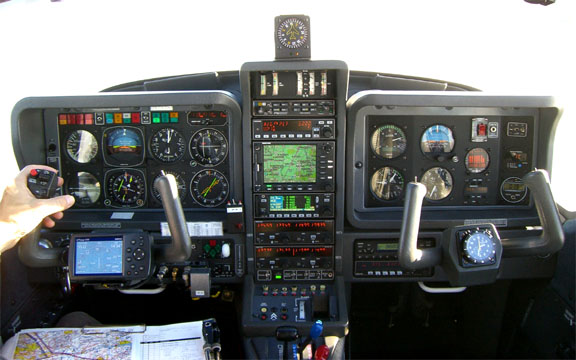
The aircraft carries a portable oxygen system described here which comprises of a large "48 cu. ft." carbon-kevlar cylinder from Mountain High
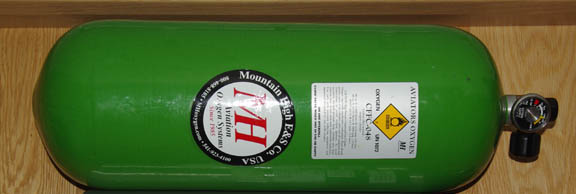
with a four-outlet Mountain High 1st stage regulator, two mechanical demand regulators feeding two standard cannulas, and two oxysaver cannulas. The system is very simple to use and the large cylinder ensures the longest trips can be done without the huge hassle of an enroute refill. On this entire trip, with 3 people, we used up 1/3 of the above cylinder. I have a large steel refill cylinder at home, rented from British Oxygen for about £100/year (£20 to swap it for a full one), and that tends to last a couple of years' flying. I also do refills for friends with similar 540-thread U.S. cylinders.
The oxygen cylinder hangs in a carry bag strapped behind the RH front seat and, together with the RH rear seat being occupied by a 4-person Survival Products life raft and a bag with emergency equipment (2xELT, GPS, ICOM radio), the aircraft has just 3 usable seats.
Planning
Checking out the airports
The objective was to get to Oristano on the west coast, which has an airport also called Oristano (LIER).
Europe - particularly southern Europe - suffers from a variable quality of published airport data and "due diligence" thus involves contacting the airport(s) directly. One can use various sources to dig out the contact information. The official publication is the national AIP; a collection of these can be found here and also at the Eurocontrol AIP database here. There are airport directories such as the Business Aviation Handbook and ACUKWIK. One can get numbers out of flight planning software; I find Navbox (which I use for simple VFR flights) reasonably good. One can google for the airport website. If one can speak the local language, a phone call is the best way, otherwise one hits the airport with faxes and emails and with a bit of luck somebody replies; usually after a few days. Airfield notams also often carry vital information. Some notes on an efficient way to do this process are here.
For this trip, the above process took longer than usual, with faxes, emails and calls spread over several days. Sardinia used to have a mayor who imposed a 150 euro (400 euro for 5-12 seats) "luxury tax" on general aviation, which led to a virtual boycott of Sardinia, which in turn apparently stopped most airfields there carrying avgas because they weren't selling any. They still tend to carry avtur because that tends to be used by higher-value aircraft whose owners are not so concerned about cost. Italy also sporadically suffers from an "avgas available but only for the aeroclub" issue which necessitates avgas availability to visitors to be 100% verified with the airfield.
The published data for Oristano shows it has no Customs, but it does show avgas. However, avgas was notamed as not available and this was confirmed by an enquiry via a pilot occasionally based there. The airport never replied to enquiries (email/fax/AFTN) so this option was abandoned. The other airports were also investigated: Olbia LIEO has Customs but no avgas (as published), Alghero LIEA states Customs and avgas but contacting them revealed no avgas... Tortoli LIET replied after a few days... no avgas and 48hrs PPR; clearly they don't want visitors. So we settled on Cagliari LIEE, with an alternate of Figari LFKF in Corsica since no other airfield in Sardinia appeared to have avgas.
There was something odd with Alghero LIEA who claimed that a notam B8494/09 shows they have no avgas, but this notam did not appear in the airfield notam data for LIEA, in August 2010. An investigation by the notam provider revealed that the notam was cancelled in March 2010. Presumably an airport issuing a notam is entitled to cancel that notam as soon as the information is sent for publication to the national AIP, but a lot of stuff in the AIPs is garbage too...
Clearly the avgas situation in Sardinia has gone severely downhill since June 2009: Great news from AOPA-Italy’s Massimo Levy – the special tax on general aviation landing in Sardinia has been cancelled! The new Governor of the region, elected in February with a huge majority, has maintained his promise and cancelled the so called ‘luxury tax’ on boats and private airplanes reaching the island. After the tax was introduced AOPA-Italy requested that GA avoid Sardinia, and many aviators and yachtsmen did so, costing the island dear. Massimo says: “We cannot say that this is a victory for AOPA, but certainly our campaign against the tax has helped to obtain this result.” Sardinia has four airports, Olbia, Cagliari, Alghero and Oristano All are open to GA, and all of them – exceptional for Italy – have avgas. Its beaches are among the prettiest of the Mediterranean and now, general aviation is again welcome. Massimo says that in particular, Olbia has one of the best organisations for GA traffic. The reality is different...
Cagliari's handling agent Aeroservice turned out to communicate very well by email and everything went smoothly. PPR was received by fax within hours.
The only nearby alternates with avgas were in Corsica. When checking out these alternate(s) it was discovered from other pilots that Figari probably has no avgas either (thought they could not be contacted to verify this, by any means) but a phone call to Ajaccio LFKJ confirmed they have it, so that became the alternate. Obviously, in an emergency an alternate is an alternate and one declares a Mayday if necessary, but landing somewhere with no fuel, and not enough fuel in the tanks to fly to somewhere with fuel, would result in a huge hassle. Avgas delivered in drums costs around 1000 euros per 200 litre barrel, plus potentially a huge amount for the carriage.
We could have flown to Oristano via a stop in a Schengen-treaty country (e.g. France) and this is how a lot of pilots work around this kind of stuff, but due to lack of fuel at Oristano such a stop would need to be reasonably close to Oristano. Corsica would do fine but my experience there is one of unpredictable turnaround times, and Oristano being VFR only (no instrument approach) and closing at sunset just complicates matters further because sub-VFR conditions would result in a diversion to Caglieri anyway. We also needed a car and one can rent one at Caglieri but not at Oristano...
Route planning
All routes were developed using FlightPlanPro. The illustrations below are screenshots from Jeppesen Flitestar, which I use mainly because it accepts the ex-FlightPlanPro route directly (via a copy/paste) and can automatically print out enroute chart sections which normally avoid any need to refer to the unwieldy printed airway charts when airborne. It also generates the plog, etc. I would not claim Flitestar is the only way to do this; FlightPlanPro itself is quite capable of printing out enough data to fly with, but I like Flitestar's presentation, but never use most of its flight planning features.
Two FL140 routes were developed for the outbound flight. The first could be flown at a lower level, down to about FL100. I normally file for FL140 as this is where IFR routings get a lot better, but one can ask for a "stop climb" at a lower level if the weather is good, but there can be problems if going below FL100-110 due to military airspace, etc.
EGKA
SITET A34 KOVAK H20 DOMOD A3 NEV R31 MTL A6 MTG Z154 TINOT M731 TEKSA M732 KOVAS
LIEE
F140
GC: 799nm Airways: 844nm
and the second is longer but would provide great views of the high Alps, although it has a FL180 section for terrain clearance
EGKA
SFD Y803 DVR/N0150F100 L10 RINTI B3 VATRI G40 ARSIL B13 SOMDA A6 DJL B37 PAS/N0150F110
G32 ODIKI/N0150F180 G32 ROCCA M135 TOP L50 LAGEN/N0150F140
L50 UNITA M858 TORTU A9 CORSI M858 RAMEN M732 KOVAS
LIEE
F140
GC: 799nm Airways: 902nm
Two return routes were developed.
A nonstop route turned out to be a reverse of the first one above - a nice result of France not having many unidirectional airways. Europe is littered with such airways which are pointless in the almost-empty lower-airway (below FL200) airspace. ATC ignore the directions in tactical traffic management anyway, and such airways just make it harder to develop a route which validates through the Brussels computer.
Due to the expected headwind, a second option with a stop at St Yan LFLN was developed. St Yan is a nice laid back airport with avgas, Customs, and an ILS. The Customs there are PNR and this was taken care of. This route is almost identical to the first one above
The CAR waypoint shown above is merely a result of a seemingly randomly picked SID going out to that waypoint. There are other SIDs at LIEE and some of them depart to the north, which is a lot more useful in this case.
Note: the Eurocontrol routings given here and elsewhere will most likely not work by the time you might try them because the precise form needed to get the route into the computer changes from one week to the next, and there are frequent differences between weekdays and weekends which are largely due to a lack of military activity on weekends.
Beware: the terrain profile shown in the route illustrations (e.g. the one above) is not accurate. The Jeppesen Flitestar software contains large elevation errors. Also, the flight level shown in the profile diagram does not relate to the flight; filed or actual.
Some notes on IFR flight in Europe are here.
Weather planning
The trip dates were set about 2 months previously but we turned out to be very lucky with the weather.
For the day of depature, the 0600 and 1200 MSLP charts showed a nice high pressure area covering almost the entire route and keeping a lot of bad weather away, to the west and east of the route. Amazingly, the next 3 days 1 2 3 were all OK too. The MSLP for the day after the trip showed a deteoriation, however. The 0600 SigWx was clean - for what that is worth. The forecast winds showed a significant tailwind the whole way.
On the morning of depature, the IR image showed no high altitude weather likely to affect a TB20 flying on an IFR clearance
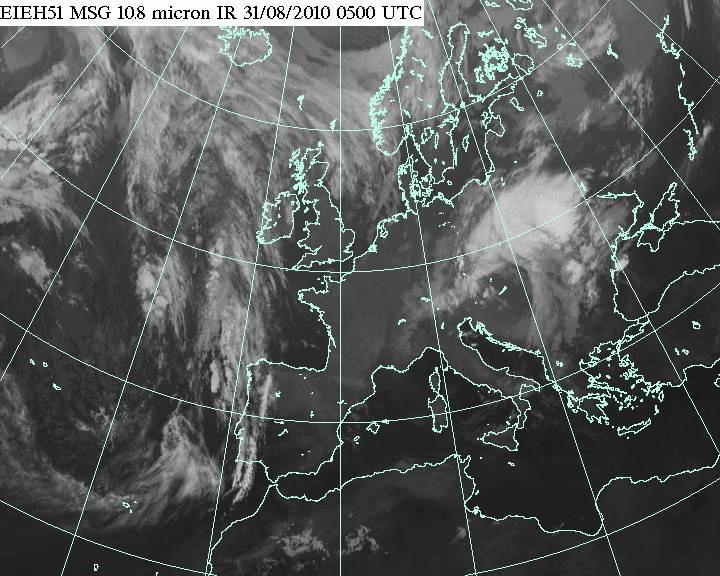
Some notes regarding the use of IR images are here. It is a simple but powerful method for looking at high altitude weather. In this case, the IR image, together with the TAFs and METARs, was a clear GO. Nowadays I make the go/no-go decision almost entirely on the IR and TAF/METAR data, taken just before departure. All the forecast data is useful for the wider picture but one would never cancel on the basis of a forecast, and obviously one would never fly into known hazardous weather even if it is unforecast.
Flight EGKA-LIEE
We filed to depart from Shoreham at the earliest possible time - engine start 0830 local time; 0840 airborne - which requires filing a PPR request on the previous day. At this early time the tower is closed so it is in effect a "farm strip departure" and IFR flights collect a provisional IFR clearance from London Information (124.60), with a handover to London Control.
The outbound flight plan was filed with EuroFPL. On the way to the airport I picked up an email (they now offer SMS too) from them advising of a Eurocontrol slot, delaying the flight by about 40 minutes. Slots are not unusual for departures to the south-east but nobody knows what daft algorithm in Brussels generates them since the "GA IFR" levels of FL100-FL200 are virtually devoid of traffic. However, one must remain ready to depart at the original departure time because most slots shrink or disappear altogether shortly before the originally filed time, and sure enough the next message from EuroFPL showed the slot to have disappeared completely...
Taxiing out, we heard an inbound pilot on the radio who was desperate to land at Shoreham, saying he needs to be somewhere in the area and the fact that his flight plan was accepted was taken as a confirmation that he can land. One could not help feeling sorry for him for this is a sad comment on the state of UK PPL training; people are not taught even the most basic things about flying from A to B. A VFR flight plan means absolutely nothing; nobody is going to acknowledge it, it is never "accepted" as such (though in some far corners of Europe it may be objected to) and nobody looks at it unless the aircraft is reported missing in which case it may indicate where to look for the wreckage. Had he got the airfield notams, he would have seen the opening hours etc in there.
On this occassion London Information took a good while to come up with the handover to London Control, but we were flying in the right direction anyway, at FL054, just below the base of Class A. Then, the IFR clearance was "on track TRACA, climb FL070, squawk 1170" and that was it. TRACA was not on the filed route but it was a useful shortcut. Due to the good weather we asked for a stop climb at FL110, which worked out well for several hundred miles
The power was set to the most economical setting of 2200rpm and (at peak EGT) 9.5USG/hr which produced 142kt TAS at -2C (ISA+5). The continuously recomputed LFOB (Landing Fuel on Board) figure soon stabilised around 27USG which is sufficient for around 3 hours of flight beyond the destination
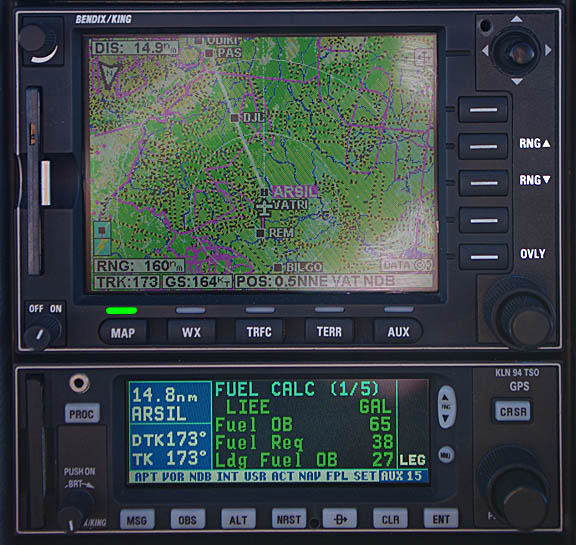
We had a good tailwind and the Alps appeared a few hours later, in a lot of haze
Unfortunately, due to the air temperature being well above standard, and possibly some sinking air, we had difficulty reaching the FL180 required for that particular Alps crossing. I told Swiss Radar that we are unable to go above FL170 due to aircraft performance, and that we will need a change of route. They instantly gave us a diversion which went around the Alps, perfectly seamlessly coordinated with France, over Cannes, via ARGIS LTP RETNO OMARD and then to rejoin the original route after Corsica
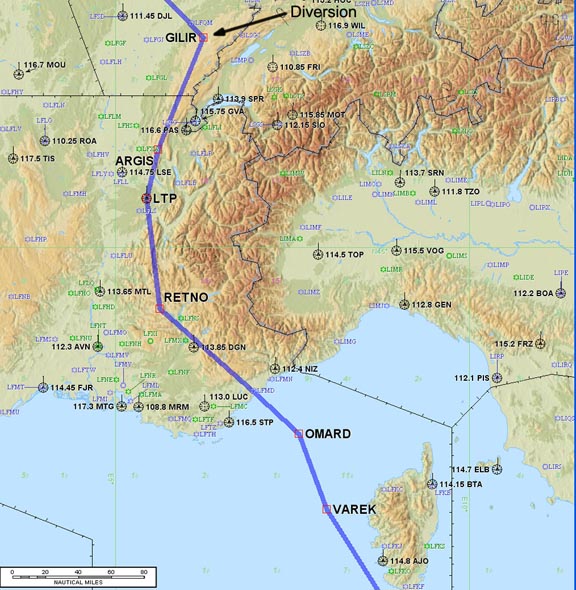
I am now sure the issue was indeed much more due to a gentle downdraught - probably around -100fpm - rather than the warmer-than-ISA conditions because within minutes of levelling off at FL170 we were doing 110kt IAS, which is 15kt above the 95kt (Vbg) which one would be doing if genuinely at one's ceiling. Only once before have I had any trouble reaching FL200, and that was flying north towards the Pyrenees, against a headwind, which ought to have produced a downdraught on the south side. The TB20 flight manual contains no useful data in this respect.
Here are some pictures from the north-east and from the west, taken from about 60nm away
Around this time, at FL170, the notorious KFC-225 autopilot failed yet again, in pitch. It was obviously again the pitch servo's torque sensor assembly which via the KC-225 autopilot computer drives the pitch trim servo. So we flew on by hand... This particular KS-270C pitch servo was only about 5 months old; and fortunately still inside its warranty.
After the Alps was a lot of terrain resembling northern Spain
The tailwind continued to build up to about 45kt, resulting in a ground speed of up to 184kt - not bad for a fuel flow of 9.5GPH! We could have descended but decided to stay high to make the best of the awesome tailwinds.
The route passed directly over Cannes LFMD; this pic is from FL170
and this is Nice, in the haze, also from FL170
Soon afterwards, the rugged island of Corsica appeared in the haze
Due to a tailwind reaching 45kt, we had seen ground speeds of up to 184kt. Here we are still doing 164kt, on a fuel flow of 9.5USG/hr and the flow computer showing 25USG at the destination
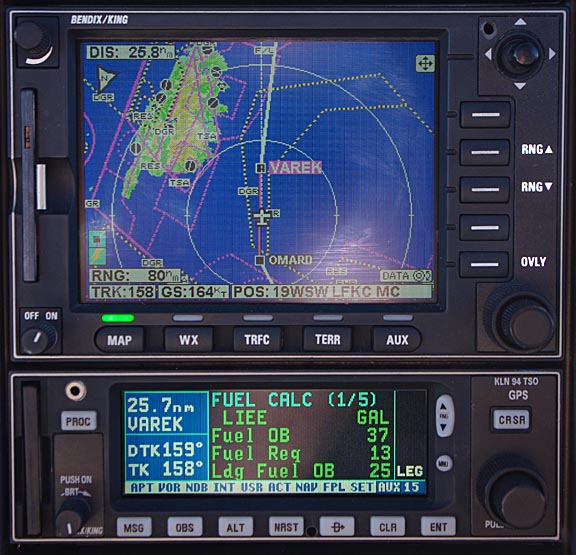
This is a view of Corsica approximately halfway along the western coast
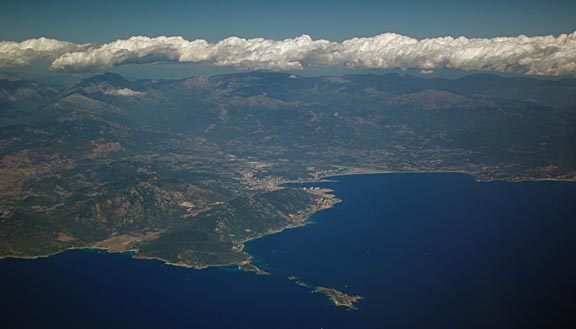
Corsica and Sardinia are very close together, with some islands between them
As I had used EuroFPL to file the flight plan, the flight progress could be monitored by someone on the ground, via a dedicated EuroFPL facility: 1 2 3 4 5.
Upon handover to Cagliari Approach, I tried to ask them which STAR they are operating (there is no ATIS) and whether the approach will be procedural or radar vectored. The controller did not understand most of this, and we (2 pilots) could not understand him either, but eventually we worked out they could not offer radar vectors due to the military. The wind was 160/12. He issued the ILS32 approach with a circle to land to runway 14. We never did establish whether it was meant to be procedural or radar vectored but after I mentioned CAR a few times he confirmed we were to fly to CAR, so it looked like it would be procedural. However, pretty soon we got vectors to the localiser! At this point the descent, originally planned for the distance to CAR and back to the ILS, had to be made drastically steeper, so it was gear down and down at -2500fpm... Here is a view at the end of the descent
On the ILS32 approach, notice how the DME reference changes from CAR to CAG after 10D, and never uses the ILS DME (IEL).
We were told we were "number two" but #1 was nowhere to be seen... with three pairs of eyes looking out I asked for a position report on #1. The Tower controller's English was a bit better than the Approach's but he did not appear to understand the question and cleared us to land. I have found on previous occassions that if an ATCO cannot understand something due to his poor English, instead of saying "say again" he ignores the call, presumably because it leaves no evidence on the tape recording. At this point several military jets, evidently coming from the Decimo airbase a few miles to the north, flew right past us, looking like they were going to land at Cagliari (and I thought they may have been what the controller referred to as #1) but they turned away...
After we landed, it became apparent that we were #1, and the mysterious #2 was this one which landed behind us ...
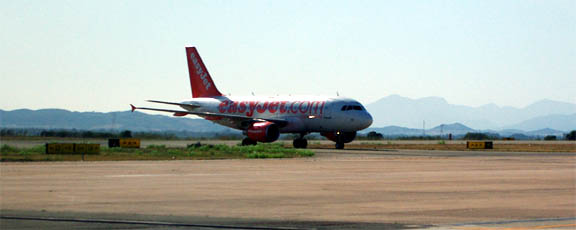
I don't think the ICAO proposals for a specific level of ATC English are particularly popular in these parts...
The handling company man was most helpful and we were refuelled and processed very fast. Avgas at Cagliari is very pricey: 2.9 euros/litre, which is nearly double the lowest prices in the EU and matches what I paid on a fly-in in Turkey in 2009. The handling was however inexpensive; about 50 euros plus a small daily parking charge, and well worth the cost for how smoothly it went

Update November 2010: Cagliari Airport sent in a bizzare email (to an address I provided on one of the forms) querying whether the aircraft was Italian operated or not. Upon receiving my reply that it obviously was not Italian operated and asking what their query was about, they sent in invoices totalling about 50 euros for miscellaneous charges e.g. "apron management", "diritti sosta" (google translation: "parking rights") etc. One has to be careful with this kind of stuff because if an airport is unable to contact the aircraft owner, they could send a bill to somebody else e.g. a previous owner, or a trustee of an N-reg aircraft. I queried it and they immediately confirmed that the handling agent had been paid and nothing was outstanding!
Total distance flown on this flight was 922nm (20nm longer due to the diversion around the Alps) and the final FOB on shutdown was 21.9USG. The difference between the pump and the flow totaliser computed fuel burn was about 1%.
The drive from the airport to Oristano was about 90 minutes, mostly on a good new road.
Oristano airport has some turboprop commercial traffic to mainland Italy which, due to there being no instrument approach, operates VFR departures and arrivals. They are planning to have instrument approaches, apparently.
A part of the reason for the trip was that one of my passengers - a Jetprop owner living outside Europe - was having some recurrent training at Oristano. The Jetprop is a very impressive aircraft which ticks a lot of boxes: FL270 ceiling, 270kt TAS, +3000fpm climb rate, pressurised, MTOW below 2000kg so no enroute charges, a zero-fuel range of about 1700nm, the lowest operating cost of any turboprop, and a great short field performance due to the awesome power to weight ratio: same takeoff power as a TBM850 but with 60% of the mass.
On the ground, the mystery of whether Oristano has avgas was only partially cleared up... here is the avgas pump, together with the Notam saying there is no avgas
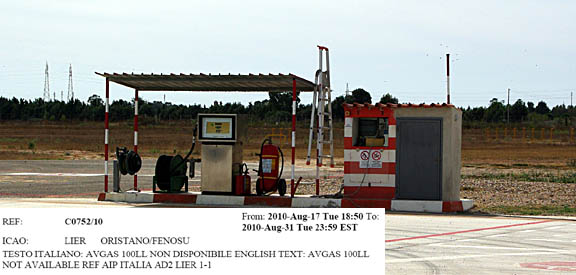
I asked around whether avgas is available but the best I could find out is that it is available only to aeroclub aircraft, or maybe only to AOPA Italy aircraft, but nobody wanted to talk about it very much.
Flight LIEE-EGKA
Due to expected headwinds, the flight was originally filed with a landing at St Yan LFLN, with Shoreham EGKA filed as the alternate. The plan was to fly to near St Yan (which lies very close to the Cagliari-Shoreham nonstop route) and divert from St Yan to Shoreham if the LFOB figure around St Yan was better than 20USG. The resulting diversion of 364nm would be a helluva diversion and it was not known how ATC would deal with it. The admin stuff was done: St Yan Customs PNR was requested and confirmed, and Shoreham was copied on the flight plan and advised of the likely diversion.
Weather planning
For the day of depature, the 0600 1200 1800 MSLP charts showed some instability (troughs) near the departure airport, and good weather on the rest of the route. The 0600 1200 1800 SigWx partly confirmed this, showing the weather over the sea and away from Sardinia. The forecast winds showed a headwind of 5-10kt along the route.
On the morning of depature, the weather was worse than the previous day's forecasts. The IR image showed two obvious thunderstorms south of Sardinia, and a big one to the east
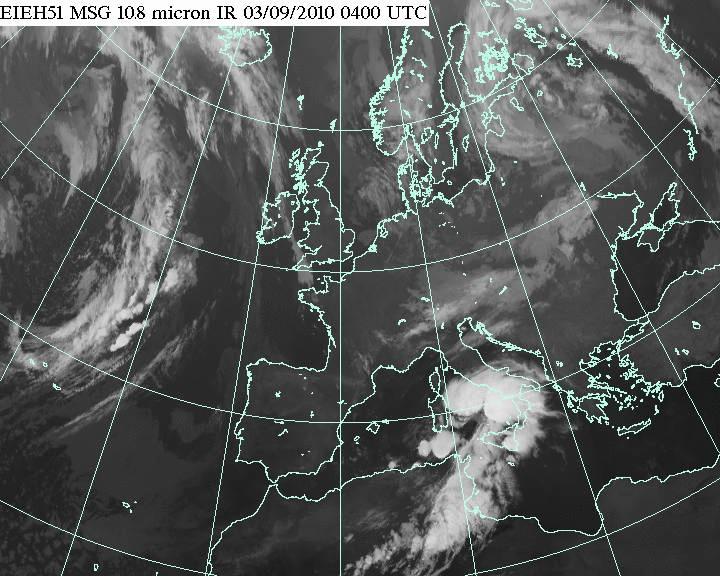
but by the time we drove to the airport, the weather was well overhead; more in line with the 0400 sferics image
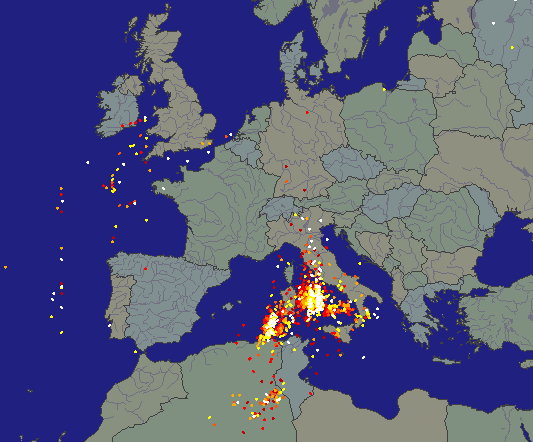
The last TAFs/METARs were pretty accurate.
It is quite a drive from Oristano to Caglieri airport, and in the end I had to delay the flight plan by 1 hour.
Normally I use EuroFPL to file flight plans but in this case the return flight plan was filed via AFPEx because AFPEx has a telephone helpdesk which can be telephoned to e.g. delay a flight plan. The other option - filing the flight plan shortly before the departure - is dodgy with IFR because Eurocontrol could reject the route for any number of reasons (which didn't exist the night before) and one then ends up having to develop a new route on the spot.
When I telephoned AFPEx to delay the flight plan by 1 hour, I got a big suprise which was contrary to my previous experience. The call was taken by an individual who told me bluntly it is not their job to do this and that the airport should do it. I phoned them again 10 mins later just to double check this and a different person confirmed I had originally spoken to the manager, and confirmed the helpdesk is there only to help with internet issues and apparently extreme cases like being on a farm strip with no internet. This is a significant development which underlines the need to sort out a better way to manage flight plan changes when on the move. At the airport, there may be no internet connectivity, or just GPRS (not 3G) which is no good if one gets hit with the seemingly random 4MB AFPEx Java application update, and locating staff with sufficient English language ability to deal with a flight plan delay using the airport's facilities may take some time.
Fortunately, EuroFPL now offer means to do all this via SMS, for $10/month or $99/year. It works well, too.
I phoned the handling agent to delay the flight plan, which he said he would do, but for some reason it didn't happen. I suspect he didn't understand what I was saying. This was all discovered when I called up, ready to go, for the departure clearance. Fortunately, the flight plan had not been dumped; it was merely "suspended" by the airport (sometime after I got home I happened to start up AFPEx and found an FLS message in the Inbox... a whole lot of use that was) and they un-suspended it right away.
Initially we were given the CAR6E departure (unsuprising given that our filed route started with CAR) but I asked for a northerly departure to take us away from the bad weather to the south - a very dark big CB was clearly visible in the direction of CAR. They then gave me the KOVAS6E departure which is a lot better. The cleared level was the filed FL140 from the outset. Plan B was to ask for a visual departure "due weather" and to remain at low level along the VFR route which depart to the NW to Oristano, until the weather was cleared and then we would try to pick up a fresh IFR clearance from either Caglieri or Alghero.
As soon as we got airborne and started the right turn, we got a DCT RAMEN which is directly north of Cagliari and that was it... there was some cloud to climb through and we had to turn left 20 to avoid one CB in which lightning started just as we flew past. The stormscope was like a christmas tree to the south; a pity I didn't get a photo...
The initial squawk of 1202 was changed by Marseilles to 7305 and later by Paris to 5631. Squawk changes are rare on Eurocontrol flights but I have seen them happen when flying at low levels; below say FL140.
As the remaining enroute weather was good
we stopped the climb at FL100 and remained there for the rest of the flight, again at the best-economy cruise setting of 2200rpm and peak EGT, yielding a fuel flow of 9.5GPH. The LFOB stabilised early on at 20USG
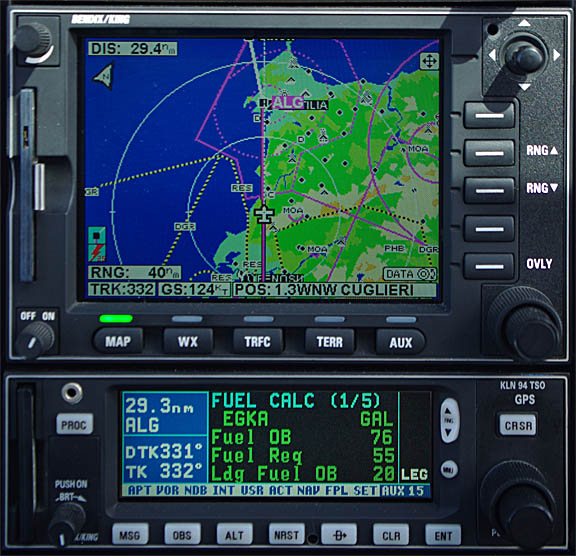
The headwind was indeed mostly 5-10kt as forecast.
About 100nm before St Yan, the LFOB was about 20USG so, together with the weather being excellent all the way (we checked the TAFs/METARs using the Thuraya 7100 satellite phone) we decided to divert to Shoreham. I gave ATC (Marseilles) the first few waypoints - NEV MOTAL DOMOD - but they seemed totally unconcerned and just sent us handed us over to Lyon who sent us onwards on the "usual" route back to the UK; same as would have been filed on the nonstop flight. They asked us to nominate a new alternate which suggested that they were knocking up a new flight plan; I gave them Lydd EGMD.
Here is St Yan from FL100 - due to the haze, barely visible in the middle of the pic
As forecast, the headwind reduced as we approached the destination but this makes little difference when the remaining distance is also reducing, so the LFOB remained at 20USG
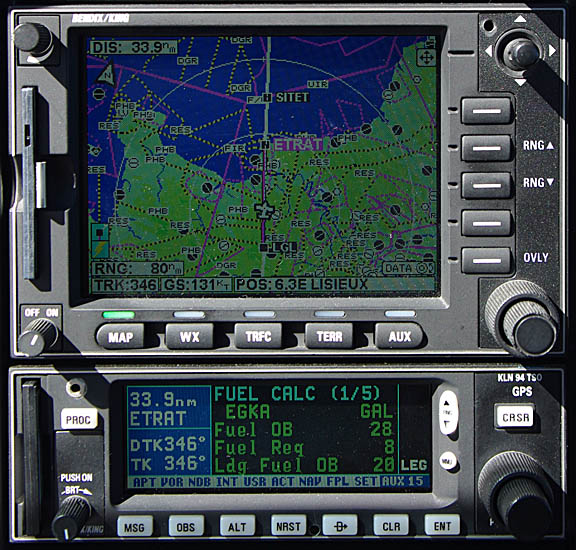
One interesting thing was that in N France we were handled by Paris Control, despite being at only FL100. This appears to be a change from past practice where Paris Control would not handle traffic below FL120, and is important to pilots flying IFR from France to the UK at sub-oxygen levels (FL100-110) who in the past used to get dumped onto London Information, with their IFR clearance being stealthily terminated in the process. It appears that of the French ATC units only Paris Control have a handover arrangement with London Control, so the only ways to preserve one's IFR clearance were to fly at FL120+, or to leave France on specific routes which led directly into lower level Class D in the UK. I have not tested the lower limits on this but have had Paris Control operate FL100 on two recent flights, and every GA piston aircraft is capable of FL100. It appears that the French are making an extra effort to make this work, because we were handled by Caen briefly (due to some military activity) and then handed back to Paris Control in time for the handover to London Control.
When trying to use up the fuel efficiently, it is important to run down one tank as completely as possible, near the end of the flight, so one can be sure that nearly all the fuel known to be on board is usable. Some pilots run one tank dry (i.e. until the engine starts to cough) but I would not go that far; I run it down about 4 USG below the "low fuel" warning which comes on when either thank goes below 7.9USG, and then there should be about 4USG in the "low" tank.
To make the best of the fuel I was continually asking for shortcuts. Near the coast we got LGL-ETRAT and then a handover to London Control who, after SITET, suggested a descent, so we did a continuous descent at -500fpm all the way to Shoreham.
Shoreham turned out to be extremely busy with about 6 in the circuit so we orbited for a while to the south. The ATC there is most competent and there wasn't a problem. Total time for the return flight was 6:50. We landed with 18.5USG in the tanks - enough for about 2 hrs of further flight. The subsequent pump refill differed by about 0.5% from the flowmeter-computed figure.
Here is the Shoreham arrivals board:
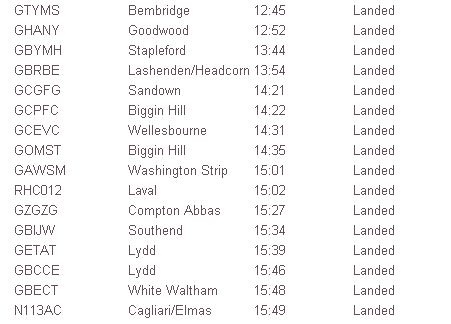
12/2010: I have come across this informal 2006 guide for Italy.
7/2012: Oristano Airport has gone bust and has been closed.
Pilot: FAA CPL/IR, approx 1200 hours at the time.
This page last edited 31st July 2012
Any feedback, reports of dead links, corrections or suggestions much appreciated: